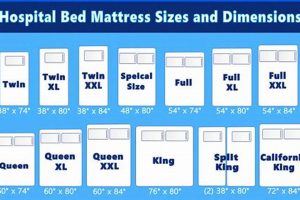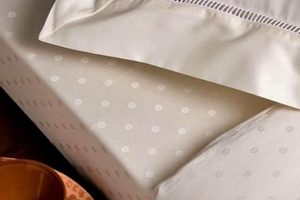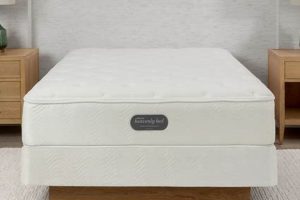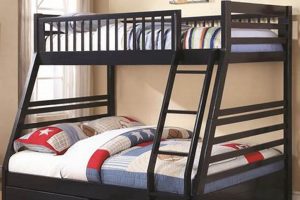A specialized sleeping surface designed for use on elevated beds with a stacked configuration. These products typically feature reduced thickness compared to standard offerings to ensure safety rail clearance and prevent falls. Their construction prioritizes comfort and support within dimensional constraints dictated by the bed frame.
Proper selection is critical for safety and a restful night’s sleep. The product must conform to height restrictions stipulated by the bunk bed’s design to minimize risk of injury. Adequate support is essential for spinal alignment and pressure relief, promoting healthy sleep posture. Historically, these items were often thin and uncomfortable; however, modern manufacturing incorporates advancements in materials and construction to enhance sleeper experience and well-being.
The subsequent sections will delve into specific dimensions, material options, safety considerations, and factors influencing the selection of a suitable product for such bed types. These elements will assist in making an informed purchase decision.
Selection Guidance
Choosing the correct sleeping surface for a stacked bed configuration requires careful consideration. The following tips provide guidance on key aspects to evaluate before making a purchase.
Tip 1: Confirm Dimensional Compatibility: Measure the interior dimensions of the bunk bed frame precisely. The sleeping surface must fit snugly within the frame to prevent movement and potential hazards. Prioritize adherence to the manufacturer’s specifications regarding length and width.
Tip 2: Observe Height Restrictions: Exceeding the maximum allowed height is a significant safety concern. Ensure that, with the surface in place, the safety rail extends sufficiently above the sleeping platform to prevent occupants from rolling out. Consult the bunk bed’s manual for recommended thickness limits.
Tip 3: Assess Support and Comfort: While thickness is limited, prioritize adequate support for the sleeper’s weight and spinal alignment. Consider options with features like memory foam or innerspring coils to distribute weight evenly and minimize pressure points.
Tip 4: Scrutinize Material Quality: Look for materials that are durable, breathable, and resistant to allergens. Certifications such as CertiPUR-US indicate that the foam components have been tested for harmful substances and emissions.
Tip 5: Evaluate Flammability Standards: Verify that the product meets applicable flammability regulations. These standards are designed to minimize the risk of fire and ensure occupant safety.
Tip 6: Consider Weight Capacity: Bunk beds have specific weight limits. Ensure that the selected sleeping surface, combined with the occupant’s weight, does not exceed the bed’s rated capacity.
Tip 7: Research Warranty and Return Policies: A comprehensive warranty and flexible return policy offer protection in case of defects or dissatisfaction with the product’s performance.
By adhering to these guidelines, a safe, comfortable, and durable sleeping solution can be selected for a bunk bed, promoting restful sleep and minimizing potential risks.
The subsequent section will address common questions and concerns regarding the selection and maintenance of these specialized sleeping surfaces.
1. Thickness Limitations
Thickness limitations are a primary constraint in the selection and design of sleeping surfaces for bunk beds. This dimensional restriction directly impacts safety, comfort, and material choices, distinguishing these products from standard mattresses.
- Safety Rail Clearance
Safety rail clearance is the paramount concern governing thickness. Exceeding the maximum allowable height compromises the protective function of the rails, increasing the risk of falls. Regulations often mandate a minimum rail height above the sleeping surface, necessitating thinner designs. Non-compliance creates a significant hazard, particularly for children.
- Weight Distribution and Support
Reduced thickness limits the options for incorporating traditional support structures found in standard mattresses. Innovative materials and construction techniques are required to provide adequate spinal alignment and pressure relief within the constrained vertical space. This often leads to the use of high-density foams or specialized coil systems designed for compression resistance in a smaller profile.
- Material Selection Constraints
The need to maintain a low profile restricts the use of bulky materials. Instead, manufacturers often employ thinner layers of memory foam, latex, or gel-infused foams, focusing on maximizing their individual performance characteristics. Material density becomes a critical factor in achieving both comfort and support without adding excessive height.
- Durability Considerations
Thinner mattresses may exhibit reduced long-term durability compared to thicker counterparts, particularly under sustained weight or stress. Reinforcements such as edge support systems and durable cover materials are often incorporated to enhance longevity and prevent sagging or deformation. The choice of high-quality materials directly influences the product’s resistance to wear and tear.
The interplay between these facets demonstrates that the thickness limitations inherent in the design of sleeping surfaces for elevated beds necessitates a careful balancing act between safety, comfort, support, and durability. Manufacturers must employ innovative engineering and material science to overcome these constraints and provide a safe and restful sleep experience.
2. Supportive Materials
The effectiveness of a sleeping surface for stacked bed configurations hinges significantly on the supportive materials utilized in its construction. Due to height restrictions inherent in the design, the selection of materials becomes paramount in providing adequate spinal alignment and pressure relief. Failure to employ appropriately supportive components results in discomfort, poor sleep quality, and potential long-term musculoskeletal issues. For instance, a thin, low-density foam pad offers inadequate support, leading to spinal misalignment and pressure point aggravation, whereas high-density memory foam or strategically configured innerspring systems effectively distribute weight, alleviating pressure and promoting proper posture.
Specific examples of supportive materials commonly incorporated include high-density polyurethane foam, memory foam, and micro-coil systems. High-density polyurethane foam provides a firm, stable base, resisting compression and maintaining its shape over time. Memory foam conforms to the sleeper’s body contours, minimizing pressure points and promoting even weight distribution. Micro-coil systems, when a
ppropriately implemented, offer targeted support and responsiveness, contouring to the body’s curves and providing localized pressure relief. The arrangement and density of these materials directly affect the level of support and comfort experienced by the sleeper. Furthermore, reinforced edge support, often constructed with high-density foam or steel rods, prevents edge collapse and maximizes the usable sleeping surface.
In conclusion, the careful selection and integration of supportive materials within sleeping surfaces designed for stacked bed configurations are critical for ensuring sleeper comfort, safety, and long-term musculoskeletal health. Height constraints necessitate a focus on material density, configuration, and performance characteristics to provide adequate support and pressure relief. The understanding of these factors allows for the informed selection of a suitable product, promoting optimal sleep quality and minimizing potential health risks associated with inadequate support.
3. Frame Compatibility
Frame compatibility constitutes a critical element in the effective function and safe utilization of a sleeping surface intended for a stacked bed. The dimensional accuracy of the sleeping surface in relation to the internal dimensions of the bed frame directly impacts its stability and the overall safety of the structure. A mismatch, wherein the sleeping surface is either too small or too large, introduces potential hazards. An undersized sleeping surface leaves gaps, presenting a risk of entrapment or instability. Conversely, an oversized sleeping surface may require undue force for installation, potentially compromising the structural integrity of the frame or creating an uneven sleep surface.
The connection between frame and sleeping surface necessitates adherence to standardized sizing and manufacturing tolerances. Reputable manufacturers provide detailed specifications regarding the dimensions of their products, enabling consumers to select items appropriately. In practice, a properly sized sleeping surface should fit snugly within the frame, minimizing movement and preventing the formation of gaps. For example, a sleeping surface designed for a “twin” sized bed frame must conform to standard twin dimensions (approximately 39 inches wide by 75 inches long). Deviation from these dimensions may result in improper fit and subsequent safety concerns. Additionally, the material composition and construction of the sleeping surface influences its compatibility with different frame types, specifically considering slat spacing or the presence of supporting structures within the frame.
In summary, the significance of frame compatibility cannot be overstated. It is a foundational consideration in ensuring the safety, stability, and intended functionality of the assembled bed system. Thorough verification of dimensions and adherence to manufacturing specifications is essential to mitigate potential risks. The selection process should prioritize dimensional accuracy and material compatibility to promote a secure and comfortable sleeping environment. Failure to consider frame compatibility may lead to structural instability, increased risk of injury, and diminished product lifespan.
4. Flammability Standards
Flammability standards constitute a crucial element in the design and manufacturing of sleeping surfaces for elevated beds, directly impacting consumer safety. These standards, often mandated by regulatory bodies, aim to minimize the risk of ignition and slow the spread of fire, providing occupants with additional time to escape in the event of a fire. The composition and construction of these products often incorporate fire-resistant materials and treatments to meet these standards. Failure to comply with these regulations introduces significant safety risks, potentially resulting in rapid fire spread, increased smoke inhalation, and limited escape time. For example, products that do not meet the standard may ignite rapidly from a small flame source, such as a cigarette lighter or a malfunctioning electrical device, quickly engulfing the room in flames and toxic smoke.
The implementation of flammability standards involves rigorous testing and certification procedures. Manufacturers must subject their products to standardized flame resistance tests, such as the open flame test and the smoldering cigarette test, to demonstrate compliance. These tests evaluate the materials’ ability to resist ignition and limit flame spread under controlled conditions. Certification from independent testing laboratories provides assurance to consumers that the product has undergone these tests and meets the required safety criteria. Furthermore, labels indicating compliance with specific flammability standards must be prominently displayed on the product, providing consumers with readily accessible information. For instance, California’s Technical Bulletin 117 (TB117) is a prevalent standard that mandates fire resistance requirements for upholstered furniture, including these sleeping surfaces.
In conclusion, flammability standards are indispensable for safeguarding against fire hazards associated with elevated bed sleeping surfaces. Compliance with these standards requires the incorporation of fire-resistant materials, rigorous testing protocols, and clear labeling. Consumers must prioritize purchasing products that meet or exceed these standards to minimize the risk of fire-related injuries and fatalities. Vigilance in selecting products that meet established fire safety criteria is essential for promoting a safe sleeping environment, especially in confined spaces or situations where occupants may have limited mobility. Ignoring flammability standards significantly elevates the risk of fire-related incidents and compromises occupant safety.
5. Weight Capacity
Weight capacity, with respect to sleeping surfaces designed for stacked beds, represents a critical safety parameter. It defines the maximum permissible load that the structure and its associated components, including the frame and sleeping surface, can safely bear without compromising structural integrity or increasing the risk of failure. Adherence to specified weight limitations is paramount for occupant safety.
- Structural Load Limits
The structural load limit represents the maximum weight that the bed frame and sleeping surface can withstand collectively. Exceeding this limit introduces stress that may lead to deformation, cracking, or complete collapse of the structure. For instance, if a bunk bed has a stated weight capacity of 250 lbs per sleeping surface, occupants exceeding that weight, either individually or combined, create a hazardous condition.
- Sleeping Surface Composition and Support
The material composition and internal support structure of the sleeping surface contribute significantly to its weight-bearing capability. Options constructed with high-density foam, reinforced innerspring systems, or robust internal bracing are typically better equipped to support heavier loads without sagging or losing shape. The composition must be considered in tandem with the structural limit of the bed frame.
- Safety Rail Integrity
While the primary fu
nction of safety rails is to prevent falls, their effectiveness is indirectly linked to weight capacity. Overloading the sleeping surface reduces the clearance between the top of the surface and the top of the safety rail, diminishing its protective function. If the surface compresses excessively under weight, the rails may become inadequate to prevent a fall, particularly for active sleepers. - Long-Term Durability and Performance
Consistent overloading of the sleeping surface, even if within the instantaneous structural limit, accelerates material fatigue and reduces the product’s lifespan. Repeated compression beyond design parameters causes the internal support structure to degrade, resulting in reduced support, sagging, and uneven sleeping surfaces. This diminishes comfort and compromises the long-term value of the product.
Consideration of weight capacity represents a fundamental aspect of selecting a suitable sleeping surface for stacked beds. It necessitates a thorough understanding of the bed frame’s specifications, the material properties of the sleeping surface, and the weight distribution of the intended occupants. Prioritizing adherence to weight limitations ensures structural integrity, maximizes safety, and extends the lifespan of the combined bed system. Failure to do so introduces significant risks and diminishes the overall value proposition.
6. Breathability
Breathability, in the context of sleeping surfaces designed for stacked beds, refers to the capacity of the materials to facilitate air circulation and moisture wicking. Inadequate breathability results in heat retention and moisture accumulation, creating an uncomfortable sleep environment. This effect is amplified in stacked bed configurations, particularly on the upper level, where stagnant air and limited ventilation are common. The accumulation of heat and moisture fosters the growth of mold and mildew, posing potential health risks, including allergic reactions and respiratory issues. The absence of proper air circulation also contributes to an elevated body temperature, disrupting sleep patterns and reducing overall sleep quality. For instance, a sleeping surface constructed entirely of closed-cell foam, without ventilation channels or breathable cover materials, traps heat and moisture, leading to discomfort and potentially unsanitary conditions.
Materials such as open-cell foam, natural latex, and cotton or bamboo-derived fabrics enhance breathability. Open-cell foam allows for greater airflow compared to closed-cell varieties, facilitating heat dissipation. Natural latex possesses inherent breathability due to its cellular structure. Cotton and bamboo fibers exhibit superior moisture-wicking properties, drawing perspiration away from the sleeper’s body. Design features, such as ventilation channels and perforated foam layers, further promote air circulation. The practical application of these principles involves selecting products that incorporate breathable materials and designs. For example, a stacked bed sleeping surface with a cotton cover, open-cell memory foam, and ventilation channels would offer superior breathability compared to a similar product constructed solely of synthetic materials.
In summary, breathability represents a critical factor in the design and selection of sleeping surfaces for stacked beds. Its impact on comfort, hygiene, and sleep quality necessitates careful consideration of material selection and product design. Prioritizing breathability mitigates the risks associated with heat retention and moisture accumulation, promoting a healthier and more restful sleep environment. The understanding of breathability characteristics empowers informed consumer choices and contributes to the overall well-being of individuals utilizing stacked bed systems. Challenges persist in accurately quantifying breathability metrics and developing standardized testing methods to evaluate and compare different products.
7. Durability
Durability, in the context of sleeping surfaces for stacked bed configurations, represents a critical performance attribute. It dictates the lifespan and sustained functionality of the product under conditions of regular use, encompassing resistance to wear, deformation, and material degradation. The inherent limitations of stacked bed designs, including restricted space and potential for concentrated weight distribution, place heightened demands on material integrity and construction quality.
- Material Fatigue Resistance
Material fatigue resistance determines the capacity of the foam, innerspring, or other core components to withstand repeated compression and decompression cycles without significant loss of support or structural integrity. Lower-quality materials exhibit premature sagging and deformation, compromising sleep comfort and spinal alignment. High-density foams and tempered steel coil systems are indicative of enhanced fatigue resistance, prolonging the useful life of the sleeping surface.
- Edge Support Integrity
Edge support integrity refers to the ability of the perimeter of the sleeping surface to maintain its shape and firmness over time, particularly under edge loading. Weak edge support contributes to roll-off and reduces the usable sleep area. Reinforced edge support systems, often constructed with high-density foam or steel reinforcement, mitigate edge collapse and enhance overall durability.
- Cover Fabric Abrasion Resistance
Cover fabric abrasion resistance dictates the ability of the outer fabric layer to withstand friction and wear from regular use, including contact with bedding, clothing, and skin. Poor abrasion resistance results in premature pilling, tearing, or seam failure, diminishing the aesthetic appeal and potentially compromising the internal structure of the sleeping surface. Durable, tightly woven fabrics, such as those incorporating high-tenacity fibers, are indicative of enhanced abrasion resistance.
- Resistance to Compression Set
Resistance to compression set quantifies the material’s ability to recover its original thickness after prolonged compression. High compression set indicates permanent deformation and reduced support. High-quality foam and innerspring components exhibit minimal compression set, retaining their shape and providing consistent support over time. This is particularly important for the upper bunk surface due to less movement over time.
These facets collectively influence the long-term value and performance of sleeping surfaces designed for elevated beds. The selection of products with robust materials, reinforced construction, and demonstrable resistance to wear and degradation is essential for ensuring a safe, comfortable, and cost-effective sleep solution over the lifespan of the bunk bed system. Compromising on durability leads to premature replacement and potentially unsafe sleeping conditions.
Frequently Asked Questions
The following addresses common inquiries regarding the selection, use, and maintenance of sleeping surfaces specifically designed for stacked bed systems. These answers aim to provide clarity and guidance to facilitate informed decisions.
Question 1: What is the standard thickness for a bunk bed sleeping surface?
The recommended thickness typically ranges from 5 to 8 inches. This limitation is imposed by safety standards requiring suffici
ent clearance between the top of the sleeping surface and the upper edge of the safety rails to prevent falls.
Question 2: Can a regular mattress be used on a bunk bed?
Use of a regular mattress is generally not recommended. Standard mattresses often exceed the maximum allowable thickness, compromising safety rail functionality. Specialized models designed for stacked beds are engineered to meet specific dimensional and safety requirements.
Question 3: How frequently should a bunk bed sleeping surface be replaced?
The lifespan varies depending on material quality, usage, and maintenance practices. However, replacement is generally recommended every 5 to 7 years, or sooner if signs of wear, sagging, or reduced support are evident.
Question 4: What type of sleeping surface material is most suitable for a bunk bed?
Options such as high-density foam, memory foam, or low-profile innerspring systems are frequently employed. The optimal choice depends on individual comfort preferences and support requirements, while adhering to height and weight limitations.
Question 5: How can the longevity of a bunk bed sleeping surface be maximized?
Regular rotation and flipping (if applicable) helps to distribute wear evenly. Use of a waterproof mattress protector safeguards against spills and stains. Adherence to weight limits prevents premature sagging and structural damage.
Question 6: Are there specific safety standards that bunk bed sleeping surfaces must meet?
Compliance with flammability standards, such as those outlined in California Technical Bulletin 117 (TB117), is essential. Verification of CertiPUR-US certification ensures that foam components meet standards for emissions and harmful substances.
These FAQs highlight the importance of safety, proper selection, and diligent maintenance in ensuring the optimal performance and longevity of sleeping surfaces for elevated beds. Prioritizing these considerations promotes a safe and comfortable sleep environment.
The subsequent section will delve into specific cleaning and maintenance practices to prolong the lifespan and hygiene of these specialized sleeping surfaces.
Conclusion
This exploration has detailed the multifaceted considerations surrounding the selection and maintenance of sleeping surfaces for stacked bed configurations. Key points include the critical importance of dimensional compatibility, adherence to flammability standards, and the balancing act between support, comfort, and durability within constrained height parameters. The unique challenges presented by this specialized product category necessitate informed decision-making to ensure safety and long-term value.
Proper attention to these factors is not merely a matter of comfort, but one of safety and well-being. As advancements in materials science and manufacturing continue, the sleeping surface options available will likely expand. However, the fundamental principles of careful selection, diligent maintenance, and adherence to established safety guidelines will remain paramount in providing a safe and restful sleep environment within the confines of a bunk bed system.


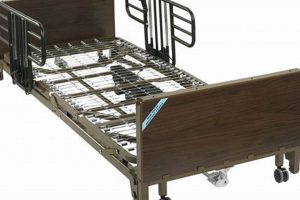
![Best Air Bed Double Mattress [Deals] For Comfy Nights! Organic & Natural Mattress Buyer’s Guide: Non-Toxic Sleep Solutions Best Air Bed Double Mattress [Deals] For Comfy Nights! | Organic & Natural Mattress Buyer’s Guide: Non-Toxic Sleep Solutions](https://mattressworldpa.com/wp-content/uploads/2025/07/th-7086-300x200.jpg)
